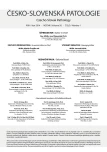Cell cultures
Authors:
Šimon Cipro 1; Tomáš Groh 2
Authors‘ workplace:
Ústav patologie a molekulární medicíny 2. LF UK a FN Motol, Praha
1; Klinika dětské hematologie a onkologie 2. LF UK a FN Motol, Praha
2
Published in:
Čes.-slov. Patol., 50, 2014, No. 1, p. 30-32
Category:
Reviews Article
Overview
Cell or tissue cultures (both terms are interchangeable) represent a complex process by which eukaryotic cells are maintained in vitro outside their natural environment. They have a broad usage covering not only scientific field but also diagnostic one since they represent the most important way of monoclonal antibodies production which are used for both diagnostic and therapeutic purposes. Cell cultures are also used as a “cultivation medium” in virology and for establishing proliferating cells in cytodiagnostics. They are well-established and easy-to-handle models in the area of research, e.g. as a precious source of nucleic acids or proteins. This paper briefly summarizes their importance and methods as well as the pitfalls of the cultivation and new trends in this field.
Keywords:
cell cultures – tissue culture – antibodies – pathology
Sources
1. Li F, Vijayasankaran N, Shen A, Kiss R, Amanullah A. Cell culture processes for monoclonal antibody production. mAbs 2010; 2(5): 466-479.
2. Cipro Š, Hřebačková J, Hraběta J, Poljaková J, Eckschlager T. Valproic acid overcomes hypoxia- induced resistance to apoptosis. Oncol Rep 2012; 27(4): 1219-1226.
3. Hayflick L, Moorhead PS. The serial cultivation of human diploid cell strains. Exp Cell Res 1961; 25: 585-621.
4. Uphoff CC, Denkmann S-A, Drexler HG. Treatment of Mycoplasma contamination in cell cultures with plasmocin. J Biomed Biotechnol 2012; 2012 (1): 267678.
5. Lincoln CK, Gabridge MG. Cell culture contamination: sources, consequences, prevention, and elimination. Methods Cell Biol 1998; 57: 49- 65.
6. Young L, Sung J, Stacey G, Masters JR. Detection of Mycoplasma in cell cultures. Nat Protoc 2010; 5(5): 929-934.
7. Volokhov DV, Graham LJ, Brorson KA, Chizhikov VE. Mycoplasma testing of cell substrates and biologics: Review of alternative nonmicrobiological techniques. Mol Cell Probes 2011; 25(2-3): 69-77.
8. Abbott A. Biology´s new dimension. Nature 2003; 424: 870-872.
9. Kleinman HK, McGarvey ML, Liotta LA, et al. Isolation and characterization of type IV procollagen, laminin, and heparan sulfate proteoglycan from the EHS sarcoma. Biochemistry 1982; 21(24): 6188-6193.
Labels
Anatomical pathology Forensic medical examiner ToxicologyArticle was published in
Czecho-Slovak Pathology

2014 Issue 1
Most read in this issue
- Lynch syndrome in the hands of pathologists
- Cell cultures
- Detection of chromosome changes by CGH, array-CGH and SNP array techniques in tumours
- Uterine tumors resembling ovarian sex cord tumors (UTROSCT). Report of a case with lymph node metastasis
